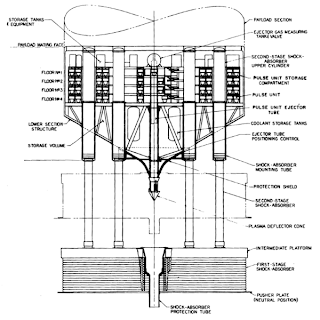As Mr. Dyson explains, this highly classified project was designed to put a man on Saturn, a feat that no one really talked about since given our difficulty in even envisioning a manned trip to Mars. In the video, Mr. Dyson describes a Marriott hotel-sized, 8 million ton, nuclear-bomb propelled (2,000 to 3,000 bombs required) space craft that would take approximately 8 passengers to a moon of Saturn, possibly Io, Ganymede, Enceladus, Titan, or Mimas. A larger version was also being planned for Jupiter that could carry a crew of 7 with room for an additional 7 scientists.
The Orion Project was halted in 1965, most likely in reaction to the new restrictions under the Partial Test Ban Treaty of 1963. But what an amazing tale of big ideas, and, I suppose, silly ideas given the planned fuel. However, Mr. Dyson claims the design may be one of the few off-the-shelf ideas for intercepting a planet killer asteroid, which may be why NASA has purchased some of the material from Mr. Dyson's archives (since NASA misplaced its copies, if they were ever shared with them).
Mr. Dyson tells more in his 2002 book
 The improbable story of the wildest idea-a space craft powered by hydrogen bombs-to come out of the space race.
The improbable story of the wildest idea-a space craft powered by hydrogen bombs-to come out of the space race.It was the late 1950s. The Cold War was raging. Sputnik had made its voyage and the space race was on. In America, it was the age of tail fins and "duck and cover," but it was also a time of big ideas and dreams. On his way to school one day, George Dyson learned of a truly fantastical idea: massive space vehicles that would be powered by explosions of multiple hydrogen bombs. Among the brilliant minds behind this project was George's father, the eminent physicist Freeman Dyson.
Project Orion chronicles this fascinating episode in U.S. scientific research, while capturing a unique time in American history and culture. The project brought together a cadre of brilliant physicists, the first such assemblage since the Manhattan Project of fifteen years earlier. In an idyllic seaside community in southern California-the very picture of 1950s suburban prosperity-a handful of scientists, tackled a massive project that required the ingenuity of an engineer and the vision of a great theoretician. Their work-ambitious but ultimately futile-took place against the political and cultural backdrop of the Cold War, when nuclear technology spelled both promise and terror.
Dyson's prodigious historical and scientific research, combined with his personal reminiscences and connections, make for a lively, richly detailed narrative.
Three cheers for big ideas, and we can only hope that other highly classified projects are thinking long term about space exploration. Of course, I would prefer a more open debate with the involvement of NASA rather than some military-only application. However, as I noted earlier, the USAF seems to prefer its own parallel space program.

